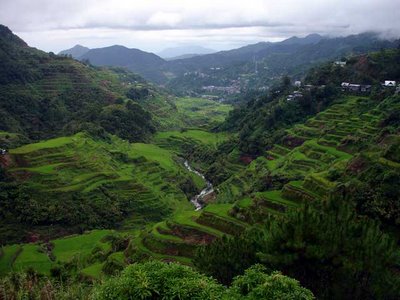 Just got back from an exhausting but fulfilling day trip to the Cordilleras. Yes, you heard me right, it was a day trip! This time the HCS was off to Bontoc, Mountain Province where a rare American period upland capitol building still stands.We all met up at Gemma's place at 11 p.m. Saturday night and were off at about 12 midnight. It was going to be a long drive up Maharlika Highway so we went to sleep for most of the trip stopping only for a short break in Bambang, Nueva Vizcaya. In Baliuag, we were caught in a major traffic jam in the brewing since an AUV had crashed into a telephone post and as a result, the wires were dangling quite low making it difficult for trucks to pass. Since it is a major truck route, imagine the long line that resulted from the accident. Anyway, we were able to manuever our way in just a few minutes but we could imagine the traffic jam we were to face if we had arrived minutes later.
Just got back from an exhausting but fulfilling day trip to the Cordilleras. Yes, you heard me right, it was a day trip! This time the HCS was off to Bontoc, Mountain Province where a rare American period upland capitol building still stands.We all met up at Gemma's place at 11 p.m. Saturday night and were off at about 12 midnight. It was going to be a long drive up Maharlika Highway so we went to sleep for most of the trip stopping only for a short break in Bambang, Nueva Vizcaya. In Baliuag, we were caught in a major traffic jam in the brewing since an AUV had crashed into a telephone post and as a result, the wires were dangling quite low making it difficult for trucks to pass. Since it is a major truck route, imagine the long line that resulted from the accident. Anyway, we were able to manuever our way in just a few minutes but we could imagine the traffic jam we were to face if we had arrived minutes later.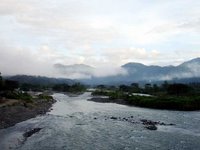 From Maharlika Highway, we made a left in Bagabag towards Banaue. By the time we entered Ifugao, the sun was up. The scenery along the way was just surreal and we had wanted to stopover by a river for a breakfast picnic but had to abandon the plan since it was difficult to find our way down to the riverbank. We had made it past Lagawe, Ifugao's capital town when we decided to find a spot along the mountain road for our picnic.
From Maharlika Highway, we made a left in Bagabag towards Banaue. By the time we entered Ifugao, the sun was up. The scenery along the way was just surreal and we had wanted to stopover by a river for a breakfast picnic but had to abandon the plan since it was difficult to find our way down to the riverbank. We had made it past Lagawe, Ifugao's capital town when we decided to find a spot along the mountain road for our picnic.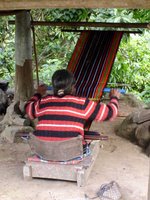 We found a clearing where we parked. Gemma had prepared cold cuts, bread, cheese, and steamed brussel sprouts and carrots, a healthy treat indeed! Then we noticed we had a flat tire. And to make things worse, there was one stubborn screw which broke our tire wrench. So the driver had to hitchhike to Banaue to look for a vulcanizing shop for help. Anyway, we were stuck for close to two hours. And by this time, Gemma had sent an SOS to the governor of Mountain Province. So a vehicle was on the way. But Bontoc was two hours away! So we just enjoyed the view and watched an old Ifugao lady weave some cloth the traditional way.
We found a clearing where we parked. Gemma had prepared cold cuts, bread, cheese, and steamed brussel sprouts and carrots, a healthy treat indeed! Then we noticed we had a flat tire. And to make things worse, there was one stubborn screw which broke our tire wrench. So the driver had to hitchhike to Banaue to look for a vulcanizing shop for help. Anyway, we were stuck for close to two hours. And by this time, Gemma had sent an SOS to the governor of Mountain Province. So a vehicle was on the way. But Bontoc was two hours away! So we just enjoyed the view and watched an old Ifugao lady weave some cloth the traditional way.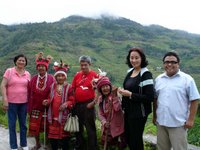 When the driver came back, they were able to replace the tire only to realize that the spare was soft as well. Oh brother! So we made a slow drive to Banaue where we had the tire inflated, pausing briefly for photos with the Banaue Rice Terraces. Sad to say, the view from Banaue town is now that of the Banaue House Terraces! Sigh! And you have to drive further out of town for better views. I wonder why the local government of Banaue did not regulate the construction and development in their area. Didn't they realize that they themselves are destroying the beauty of the rice terraces they are promoting to tourists?
When the driver came back, they were able to replace the tire only to realize that the spare was soft as well. Oh brother! So we made a slow drive to Banaue where we had the tire inflated, pausing briefly for photos with the Banaue Rice Terraces. Sad to say, the view from Banaue town is now that of the Banaue House Terraces! Sigh! And you have to drive further out of town for better views. I wonder why the local government of Banaue did not regulate the construction and development in their area. Didn't they realize that they themselves are destroying the beauty of the rice terraces they are promoting to tourists?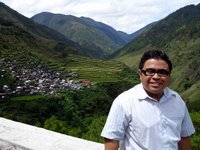 A few kilometers from Banaue, we finally saw the vehicle sent by the governor and decided to transfer. Since the driver was already used to driving along the rough mountain road, we were moving faster now. Of course, we could not resist the photo opportunities along the way, views of mountain villages such as Bayyo, perched beside the rice terraces which their ancestors built. Then we saw Bontoc, the capital town which appeared like a hidden metropolis in the mountains. It's sad though that the current architecture in the Philippines is so nondescript and lacks character. The view of Bontoc would have been more charming if the architectural character of the place was maintained.
A few kilometers from Banaue, we finally saw the vehicle sent by the governor and decided to transfer. Since the driver was already used to driving along the rough mountain road, we were moving faster now. Of course, we could not resist the photo opportunities along the way, views of mountain villages such as Bayyo, perched beside the rice terraces which their ancestors built. Then we saw Bontoc, the capital town which appeared like a hidden metropolis in the mountains. It's sad though that the current architecture in the Philippines is so nondescript and lacks character. The view of Bontoc would have been more charming if the architectural character of the place was maintained.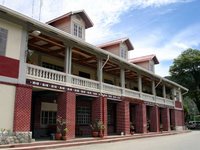 We went straight to the capitol to take photos for our 2007 HCS Calendar. The facade of the capitol had just been renovated in April, the wooden windows replace by metal ones. Sigh! But most of it was still intact. So we took our photos.Governor Maximo Dalog, who had graciously sent his vehicle to rescue us, was there to meet us. Inside his office, he served us native coffee and patupat, their native rice cake which was shaped into small triangles. We stayed in his office for quite a while since Gemma interviewed him for her TV and radio show.
We went straight to the capitol to take photos for our 2007 HCS Calendar. The facade of the capitol had just been renovated in April, the wooden windows replace by metal ones. Sigh! But most of it was still intact. So we took our photos.Governor Maximo Dalog, who had graciously sent his vehicle to rescue us, was there to meet us. Inside his office, he served us native coffee and patupat, their native rice cake which was shaped into small triangles. We stayed in his office for quite a while since Gemma interviewed him for her TV and radio show.
We had lunch at the Cable Cafe & Restaurant which was located in an old upland house. You could see the difference between the lowland and upland dwellings and sadly, there are not much of these colonial mountain homes and shophouses left. Before lunch, we were treated to an impromptu wine-tasting session as various lang-ay festival wines were brought out. They served us sorelle (cacao), bugnay and rice wines which were really great! I mixed some bugnay and sorelle wine with my pineapple juice and the result was a delicious cocktail which Gemma named Bontoc Embrace. Hehe!
 After the hearty lunch, we were brought to the Bontoc Museum which was housed in buildings designed like Bontoc huts. Right beside it was an old Catholic school founded in 1911, the St. Vincent's Elementary School which was a complex of wooden and brick buildings (more photos here). I had noticed a sign which showed a new building and fund-raising efforts for it. So I asked where it was going to be built. And to my horror, they were going to demolish some old ones.
After the hearty lunch, we were brought to the Bontoc Museum which was housed in buildings designed like Bontoc huts. Right beside it was an old Catholic school founded in 1911, the St. Vincent's Elementary School which was a complex of wooden and brick buildings (more photos here). I had noticed a sign which showed a new building and fund-raising efforts for it. So I asked where it was going to be built. And to my horror, they were going to demolish some old ones.
So I immediately talked to the governor and it turned out that the tourism officer who was with us was the president of the parents' association of the school. So we were able to make them realize the value of the old buildings and they will be contacting some heritage architects for advise on how to go about restoring them.
 Our plan was to visit nearby Sagada and Maligcong Rice Terraces but thanks to our flat tire fiasco, we had to make our way back to Manila. Sigh! This time, we stopped along the road for more photos. Despite the rough road which the governor calls the "Bontoc Massage," the view of the natural heritage of the Philippines at its finest makes any trip up the Cordilleras most worth it. I hope it stays that way!
Our plan was to visit nearby Sagada and Maligcong Rice Terraces but thanks to our flat tire fiasco, we had to make our way back to Manila. Sigh! This time, we stopped along the road for more photos. Despite the rough road which the governor calls the "Bontoc Massage," the view of the natural heritage of the Philippines at its finest makes any trip up the Cordilleras most worth it. I hope it stays that way!
One of our last stops was the marker of the Philippine Institute of Civil Engineers and the American Society of Civil Engineers (more photos here). Aside from being a National Cultural Treasure and a UNESCO World Heritage Site, the Ifugao Rice Terraces had also been designated as an International Historic Civil Engineering Landmark. So that is more reason to preserve it, moreso since it was among the 100 Most Endagered Sites for 2000, and still among 34 sites listed in the World Heritage in Danger List.
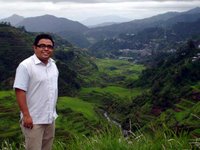 This marked viewpoint offers one of the better views of the rice terraces in Banaue. I think this viewpoint was the highlight of our trip thanks to the magnificent view and the cool mountain weather. From there, we proceeded to the Banaue Hotel where we had some coffee.
This marked viewpoint offers one of the better views of the rice terraces in Banaue. I think this viewpoint was the highlight of our trip thanks to the magnificent view and the cool mountain weather. From there, we proceeded to the Banaue Hotel where we had some coffee.
After coffee, it was off to Manila and another long nap. And we thought it was all over when we realized when we stopped over in Cabanatuan that our aircon fanbelt was broken. Good thing the weather was cool so the trip back to Manila wasn't that uncomfortable and the next thing I knew, we were back in Makati, a little over 24 hours after we had departed. It's now time to get more sleep! Hehe!
I just made a petition to the Catholic Bishops Conference of the Philippines (CBCP). To read and sign the petition, please visit http://www.petitiononline.com/cbcp. To check out who's signed the petition and what they have to say, click here.
A Filipino society that values and preserves its cultural heritage in order to instill pride of place and strengthen Philippine national identity... we can all make a big difference in our fight to preserve our cultural heritage!
I was on my own today since the heritage sites I was going to visit next were in Camarines Sur, particularly those along the Pacific coast in the southeastern part of the province around Lagonoy Gulf. And I was going to take the road less-traveled, a short cut from Tiwi to Sagñay, Camarines Sur which few people use. It was so remote and rarely used in fact that only one jeep plied the route leaving Tiwi only three times a day at 7 a.m., 9 a.m. and 1 p.m.
I set the alarm at 4:30 a.m. but I was just too tired so the next thing I knew, the caretaker of the guesthouse was knocking at my door at 5:15 a.m. Good thing I told him I planned to leave early. I took a jeep to the central terminal from outside the guesthouse, that was PHP7.50. At the terminal, there were FX taxicabs to various towns around Albay, Tiwi included. But after waiting for thirty minutes, still not much passengers and I was worried I would not make it in time for the 9 a.m. departure from Tiwi. So I heeded the advice of one of the dispatchers that I take a bus to Tabaco City where jeeps to Tiwi left regularly. Good thing I did since when I arrived in Tabaco, I was easily led to a jeep to Tiwi.
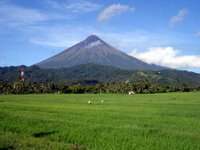 I made sure I sat on the left side of the bus as it offered the best views of Mayon Volcano. The mountain was nice to me today since there was not a single cloud in sight and I got to see about 180 degrees of it. The ordinary bus to Tabaco from Legazpi was just PHP20. While the jeep from Tabaco to Tiwi was PHP15.50. I arrived in Tiwi at about 8:30 a.m.
I made sure I sat on the left side of the bus as it offered the best views of Mayon Volcano. The mountain was nice to me today since there was not a single cloud in sight and I got to see about 180 degrees of it. The ordinary bus to Tabaco from Legazpi was just PHP20. While the jeep from Tabaco to Tiwi was PHP15.50. I arrived in Tiwi at about 8:30 a.m.
The jeep actually goes as far as Tigaon. The cost of the jeep from Tiwi to Sagñay was PHP45 for the approximately one and a half hour ride that took us along a road in surprisingly good condition that zigzagged high up on cliffs that hugged the Pacific coastline of Bicol, offering breathtaking views of the black sand beaches and outlying emerald colored islands. It was a pity I couldn't tell the jeep to stop so that I could take photos. In Sagñay (pronounced Sangay), I went straight to the church. I was met by a CAT troop complete with a marching band practicing for a parade of sorts. Nice! The church was a little altered outside but still ok. When I got inside, I saw that an upcoming renovation was in the works as seen from the billboard. They plan to make the interior to look like that of the St. Peter's Basilica. We need to educate our priests and parish pastoral councils that Philippine religious art is unique, its elegance in its folksy simplicity.
In Sagñay (pronounced Sangay), I went straight to the church. I was met by a CAT troop complete with a marching band practicing for a parade of sorts. Nice! The church was a little altered outside but still ok. When I got inside, I saw that an upcoming renovation was in the works as seen from the billboard. They plan to make the interior to look like that of the St. Peter's Basilica. We need to educate our priests and parish pastoral councils that Philippine religious art is unique, its elegance in its folksy simplicity.
From Sagñay, I took a quick motorbike ride to the next town Tigaon which was PHP15. Nice facade which I heard was funded by a family in the 1930s from money then won in the Sweepstakes. But again, when I got inside, another billboard announcing the need for P10.8 million! The church was also up for renovation.
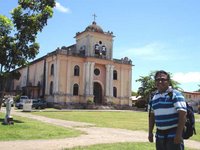 From the detailed plans, it showed they were going to replace the original clay tiles with granite. That component alone was a million pesos! I didn't see the need to change the flooring. It was an unnecessary and ostentatious expense that would make happy only the contractors and the priest whose whims and caprices were satisfied. Such money which priests extract from the townsfolk through all this fundraising hullabaloo could be used for the real pastoral mission of the Church which is definitely not construction.
From the detailed plans, it showed they were going to replace the original clay tiles with granite. That component alone was a million pesos! I didn't see the need to change the flooring. It was an unnecessary and ostentatious expense that would make happy only the contractors and the priest whose whims and caprices were satisfied. Such money which priests extract from the townsfolk through all this fundraising hullabaloo could be used for the real pastoral mission of the Church which is definitely not construction.
I talked to the parish priest but you could see that his mind was set on wasting all that money for the renovations. And to think Tigaon is just a 4th class municipality. Such hypocrisy from the Church if they spend P10.8 million or even more for the renovations. You can contact the St. Clare of Assisi Parish in Tigaon, Camarines Sur at (054) 4523004. Tell the priests there what you think about their plan to spend millions for construction to emulate some church in First World Europe.
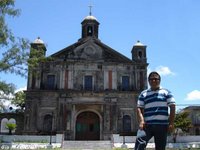 From Tigaon, I took a jeep to Goa which was PHP10. Goa had a large church with its courtyard dissected by a road which passed in front of the structure. The original gates and walls were still standing. But there was a permanent concrete structure in the middle of the patio (the one used for the salubong which had four posts each with balconies for angels and a hole at the top for the main angel to be lowered from) blocking the view from the main gate. I would later learn that this was a staple structure for churches in Camarines Sur. The sad part was that some were right smack in front of the church such as in Lagonoy, when they could have been put on the side.
From Tigaon, I took a jeep to Goa which was PHP10. Goa had a large church with its courtyard dissected by a road which passed in front of the structure. The original gates and walls were still standing. But there was a permanent concrete structure in the middle of the patio (the one used for the salubong which had four posts each with balconies for angels and a hole at the top for the main angel to be lowered from) blocking the view from the main gate. I would later learn that this was a staple structure for churches in Camarines Sur. The sad part was that some were right smack in front of the church such as in Lagonoy, when they could have been put on the side.
 I had lunch in Goa and good thing there was an air-conditioned fastfood joint there. From Goa, I took a bus to Lagonoy. That was PHP8. Along the way, I saw the church in San Jose and decided I would stopover on the way back. As I mentioned, Lagonoy had a very charming church which was constructed amid a backdrop of mountains. The old gates and walls were still standing and it would have been a classic example of the lay-out of colonial churches had it not been for that concrete canopy they constructed right at the gates, in front of the church itself. Again, the inside was renovated! So it was off to San Jose.
I had lunch in Goa and good thing there was an air-conditioned fastfood joint there. From Goa, I took a bus to Lagonoy. That was PHP8. Along the way, I saw the church in San Jose and decided I would stopover on the way back. As I mentioned, Lagonoy had a very charming church which was constructed amid a backdrop of mountains. The old gates and walls were still standing and it would have been a classic example of the lay-out of colonial churches had it not been for that concrete canopy they constructed right at the gates, in front of the church itself. Again, the inside was renovated! So it was off to San Jose.
 Although it was not among the churches suggested to Gemma, I decided to stopover, attracted by the facade. Thus I was so surprised when I entered since it turned out to be the best-preserved of all the churches I visited in the past two days. Inside, I could easily distinguish the smell of age as I marveled at the well-preserved wall and ceiling murals (see photo below) the colors of which reminded so much of Tayabas. The San Jose Church definitely deserves to be declared a national historical landmark at the very least! What a shame if I decided to skip this church entirely!
Although it was not among the churches suggested to Gemma, I decided to stopover, attracted by the facade. Thus I was so surprised when I entered since it turned out to be the best-preserved of all the churches I visited in the past two days. Inside, I could easily distinguish the smell of age as I marveled at the well-preserved wall and ceiling murals (see photo below) the colors of which reminded so much of Tayabas. The San Jose Church definitely deserves to be declared a national historical landmark at the very least! What a shame if I decided to skip this church entirely!
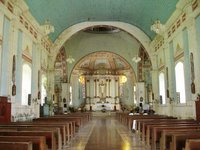 As I left, a funeral procession was about to enter the church and you could hear the play of the church bells. I remember that the tune played by the bells announced to the public a message, that someone was getting married, that it was fiesta time, that a male or female died and there was a requiem Mass, etc. and each had a particular tune.
As I left, a funeral procession was about to enter the church and you could hear the play of the church bells. I remember that the tune played by the bells announced to the public a message, that someone was getting married, that it was fiesta time, that a male or female died and there was a requiem Mass, etc. and each had a particular tune.
 From San Jose, I took a bus straight Naga City. It wasn't difficult to board one since they left Lagonoy quite regularly. It costed PHP40. The view along the way was also great since you had Mount Isarog on your right and Mount Iriga (below) on your left. While on the bus, it started to rain which was good since it brought down the temperature.
From San Jose, I took a bus straight Naga City. It wasn't difficult to board one since they left Lagonoy quite regularly. It costed PHP40. The view along the way was also great since you had Mount Isarog on your right and Mount Iriga (below) on your left. While on the bus, it started to rain which was good since it brought down the temperature.
 I arrived in Naga at about 3:30 p.m. and the first thing I did was to purchase a ticket back to Manila. This time I made sure to purchase the Philtranco Gold Service ticket since their executive buses had airline seats and were more spacious. It costs PHP200 more than the regular aircon bus at PHP800 plus PHP6 for insurance. The bus was going to leave at 9 p.m. so just enough time to explore Naga.
I arrived in Naga at about 3:30 p.m. and the first thing I did was to purchase a ticket back to Manila. This time I made sure to purchase the Philtranco Gold Service ticket since their executive buses had airline seats and were more spacious. It costs PHP200 more than the regular aircon bus at PHP800 plus PHP6 for insurance. The bus was going to leave at 9 p.m. so just enough time to explore Naga.
 When that was done, I took a tricycle from the terminal to the Naga Cathedral which had a large centuries old seminary building right beside it, the Holy Rosary Seminary. The Naga Cathedral was itself monumental. But inside, you could see that the interior had already been renovated, seemingly by the same group which is planning to make St. Peter's Basilicas out of the other Camarines churches. Indeed, St. Peter's is a work of art but we have our own Filipino church art which we must endeavor to preserve. Let's not try to erase what makes us uniquely Filipino.
When that was done, I took a tricycle from the terminal to the Naga Cathedral which had a large centuries old seminary building right beside it, the Holy Rosary Seminary. The Naga Cathedral was itself monumental. But inside, you could see that the interior had already been renovated, seemingly by the same group which is planning to make St. Peter's Basilicas out of the other Camarines churches. Indeed, St. Peter's is a work of art but we have our own Filipino church art which we must endeavor to preserve. Let's not try to erase what makes us uniquely Filipino.
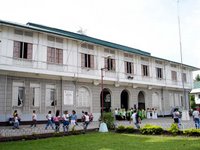 From the Naga Cathedral, I took another tricycle to the Peñafrancia Shrine. But along the way, I chanced upon the Camarines Sur National High School's Gabaldon building and told the driver to drop me off there instead. I had known from old photos that the old Pampanga High School building had a twin in Naga and finally, I found it! It was quite well-preserved so I immediately texted our friends in Pampanga that we now have a basis for the interior of the old PHS when we restore it since the buildings are close to 100% identical.
From the Naga Cathedral, I took another tricycle to the Peñafrancia Shrine. But along the way, I chanced upon the Camarines Sur National High School's Gabaldon building and told the driver to drop me off there instead. I had known from old photos that the old Pampanga High School building had a twin in Naga and finally, I found it! It was quite well-preserved so I immediately texted our friends in Pampanga that we now have a basis for the interior of the old PHS when we restore it since the buildings are close to 100% identical.
 From there, I walked to the shrine. A wedding has just finished and the floor was full of rose petals. The original image of Our Lady of Penafrancia was no longer there and had been transferred to a bigger church, the Peñafrancia Basilica Minore a few meters away. Except for the finish of the facade, the church and its convent remained mostly untouched. I noticed the gravestones on the floor had been smoothened out, obviously by the large number of devotees visiting the shrine and there was no longer a trace that a name used to be carved on them. Sad!
From there, I walked to the shrine. A wedding has just finished and the floor was full of rose petals. The original image of Our Lady of Penafrancia was no longer there and had been transferred to a bigger church, the Peñafrancia Basilica Minore a few meters away. Except for the finish of the facade, the church and its convent remained mostly untouched. I noticed the gravestones on the floor had been smoothened out, obviously by the large number of devotees visiting the shrine and there was no longer a trace that a name used to be carved on them. Sad!
From there, it was off to the Peñafrancia Basilica Minore which was another tricycle ride away. This was the second time I visited the church. There was a restaurant in the compound so I decided to have dinner there.
 I realized that I had forgotten to visit another site, the monument in downtown Naga dedicated to the Fifteen Martyrs of Bicol. So by the time I got there, it was dark. Nevertheless, I was able to take photos of this elegant monument. They don't make monuments like these nowadays.
I realized that I had forgotten to visit another site, the monument in downtown Naga dedicated to the Fifteen Martyrs of Bicol. So by the time I got there, it was dark. Nevertheless, I was able to take photos of this elegant monument. They don't make monuments like these nowadays.
It was then back to the station where I decided to wait it out at the airconditioned office of Philtranco. At least I was able to rest. I got on the bus expecting to get a good night's sleep. But I was rudely awakened somewhere in Tagkawayan, Quezon since we were driving along the worst roads I've ever seen with more potholes than craters on the moon. The rough roads and the zigzagging kept me awake for most of the southern Quezon leg. But I was able to sleep better as we neared Manila since the next thing I knew, the driver was waking me up since we were already in Pasay, and I was the only one left on the bus. It reminded me so much of my trip from Vientiane to Bangkok on executive class as well since I was in still in lalaland when we arrived in Bangkok.
Anyway, until the next trip. Do visit my travel photos at http://ivanhenares.multiply.com/photos and my heritage photos at http://photos.yahoo.com/ivanhenares since there are more photos of the sites I described in this entry as well as previous ones.
It was another heritage hunting expedition for me, this time in Bicol. Since we wanted to include reresentative municipios from Bicol in the 2007 HCS calendar, I went there to check out the Tabaco City Hall among others. Anyway, I took the Philtranco bus that left Pasay at 8 p.m. The usual ride to Bicol would take 10 hours. But the roads in southern Quezon were just horrible so that delayed us by close to two hours (yes, the roads were that bad). And I arrived in Legazpi City close to 8 a.m.I was met at the Legazpi Central Terminal by the staff of the provincial tourism office. Gemma had made arrangements with the governor for them to take me around Albay to search for heritage structures. After a brief stop at the office to meet with the provincial tourism officer, and at the Government Guesthouse to freshen up and drop off my stuff, we were off.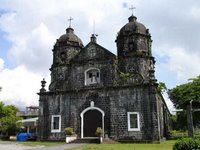 The first stop on the itinerary was the town of Sto. Domingo, the hometown of Sarung Banggi composer Potenciano V. Gregorio. They have a nice church, the Sto. Domingo de Guzman Church, with two symmetrical bell towers on both sides of the facade. This was compeleted sometime in 1832. Sad to say, entering the church was a disappointment, since it was renovated as always. Oh those priests! They like leaving their mark no matter how ugly! It was a pity since the facade was quite charming.In the small plaza in front of the church is a monument to Andres Bonifacio (they say Bonifacio had a girlfriend from the town which is why they built a monument there) and the mausoleum of Potenciano V. Gregorio.
The first stop on the itinerary was the town of Sto. Domingo, the hometown of Sarung Banggi composer Potenciano V. Gregorio. They have a nice church, the Sto. Domingo de Guzman Church, with two symmetrical bell towers on both sides of the facade. This was compeleted sometime in 1832. Sad to say, entering the church was a disappointment, since it was renovated as always. Oh those priests! They like leaving their mark no matter how ugly! It was a pity since the facade was quite charming.In the small plaza in front of the church is a monument to Andres Bonifacio (they say Bonifacio had a girlfriend from the town which is why they built a monument there) and the mausoleum of Potenciano V. Gregorio. From Sto. Domingo, we moved to the next town Bacacay and the Sta. Rosa de Lima Church. Again, this nice church was renovated inside. Sigh! Right beside it were ruins of an older church and one could still recognize some of its features.The next town was Malilipot and its church under the patronage of Our Lady of Mount Carmel. Nice facade but again renovated inside.
From Sto. Domingo, we moved to the next town Bacacay and the Sta. Rosa de Lima Church. Again, this nice church was renovated inside. Sigh! Right beside it were ruins of an older church and one could still recognize some of its features.The next town was Malilipot and its church under the patronage of Our Lady of Mount Carmel. Nice facade but again renovated inside. We were then off to Tabaco City which is home to the only national cultural treasure in Bicol, the San Juan Bautista Church. I wonder why the National Museum even considered this church a national cultural treasure. Except for its massive belfry which I must admit is quite an impressive work of art and engineering, the rest of it has been altered just like every other church I've been to in Albay. I wonder how this trend started. But it was sad entering every church seeing the interiors altered.
We were then off to Tabaco City which is home to the only national cultural treasure in Bicol, the San Juan Bautista Church. I wonder why the National Museum even considered this church a national cultural treasure. Except for its massive belfry which I must admit is quite an impressive work of art and engineering, the rest of it has been altered just like every other church I've been to in Albay. I wonder how this trend started. But it was sad entering every church seeing the interiors altered. The facade of the Tabaco Church itself has new oversized stained glass windows. While the old santos in the retablos have been replaced by new ones. If you were to ask me, the candidates for national cultural treasure in Albay should have been the churches in Daraga or Camalig. Oh well!
The facade of the Tabaco Church itself has new oversized stained glass windows. While the old santos in the retablos have been replaced by new ones. If you were to ask me, the candidates for national cultural treasure in Albay should have been the churches in Daraga or Camalig. Oh well! We then checked out the city hall which I had travelled so far to see. I wasn't quite pleased with what I saw. Indeed, it is the most well-preserved municipio in Albay, but there was so much clutter because of ongoing basketball competitions, the entire perimeter fence was covered with galvanized iron sheets maybe because they charged entrance to the games and with the cover, bystanders could not watch. We were also told it was Spanish colonial. But it turns out, the city hall was built during the American colonial period, very typical of town buildings during that time. Oh well, so much for that calendar photo.The group had lunch in Tabaco and naturally, I had Bicol express among others. What a shame if I did not eat any Bicol express while in Bicol. But the one I had for lunch wasn't that spicy. After lunch, we drove to Malinao but since it was scorching hot and the church wasn't that appealing, I decided not to go down anymore.
We then checked out the city hall which I had travelled so far to see. I wasn't quite pleased with what I saw. Indeed, it is the most well-preserved municipio in Albay, but there was so much clutter because of ongoing basketball competitions, the entire perimeter fence was covered with galvanized iron sheets maybe because they charged entrance to the games and with the cover, bystanders could not watch. We were also told it was Spanish colonial. But it turns out, the city hall was built during the American colonial period, very typical of town buildings during that time. Oh well, so much for that calendar photo.The group had lunch in Tabaco and naturally, I had Bicol express among others. What a shame if I did not eat any Bicol express while in Bicol. But the one I had for lunch wasn't that spicy. After lunch, we drove to Malinao but since it was scorching hot and the church wasn't that appealing, I decided not to go down anymore.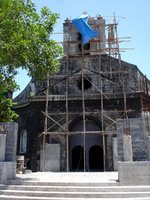 From there it was off to Tiwi. Looking at the pictures, I was expecting a very quaint church. But we got the shock of our lives when we arrived there since it was currently undergoing uglification! They were plastering the adobe with a layer of cement and were beginning to contruct an oversized portico in front of the church which would completely ruin the facade!I immediately texted Archt. Rino Fernandez who heads the Bicol Heritage Program at Aquinas University. He told me that they had already talked to the bishop who agreed that no more old churches would be defaced. They had already stopped construction a month ago but the parish priest is just so hard headed! So they are at it again!
From there it was off to Tiwi. Looking at the pictures, I was expecting a very quaint church. But we got the shock of our lives when we arrived there since it was currently undergoing uglification! They were plastering the adobe with a layer of cement and were beginning to contruct an oversized portico in front of the church which would completely ruin the facade!I immediately texted Archt. Rino Fernandez who heads the Bicol Heritage Program at Aquinas University. He told me that they had already talked to the bishop who agreed that no more old churches would be defaced. They had already stopped construction a month ago but the parish priest is just so hard headed! So they are at it again!
The parish priest is Fr. Jun Barquez and their phone number is (052) 4885187. For crying out loud father, stop wasting church money. You keep on asking donations from the townsfolk for these renovations which are not even needed, for what? So that you could say you left a mark on the church no matter how ugly? I noticed he had a donation box for evangelization, so why not use the money there instead? Sometimes you can't understand the logic of these priests. It's a waste of church money! They seem to like making the contractors happy.Anyway, Tiwi is known for its halo-halo so we stopped over to have some at a place called DJC Halo-halo a few meters from the church. Not bad at all. But the ones we have in Pampanga have richer flavors. I guess I'm just used to those.
 From Tiwi, it was a long drive to Libon which was on the other side of Albay. Nothing much left there, not even an old church, which is a pity because this used to be Villa Santiago de Libon, the fourth villa established by the Spaniards in the archipelago. We then drove to Polangui, Oas and Ligao City. The next stop was Guinobatan. And on the way, we stopped along the road to buy a snack, a very popular delicacy known as macapuno rice puto which was two layers of puto, one purple and one white with a rich macapuno filling in the center. Yummy!
From Tiwi, it was a long drive to Libon which was on the other side of Albay. Nothing much left there, not even an old church, which is a pity because this used to be Villa Santiago de Libon, the fourth villa established by the Spaniards in the archipelago. We then drove to Polangui, Oas and Ligao City. The next stop was Guinobatan. And on the way, we stopped along the road to buy a snack, a very popular delicacy known as macapuno rice puto which was two layers of puto, one purple and one white with a rich macapuno filling in the center. Yummy!
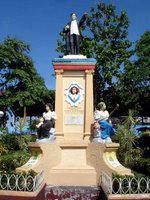 Anyway, Guinobatan struck me because of the colorfully painted municipio, church and monuments, very typical of structures at that time. We just don't realize it because photos are in black and white but facades of buildings during the Spanish and American colonial periods used to be colored quite lively.
Anyway, Guinobatan struck me because of the colorfully painted municipio, church and monuments, very typical of structures at that time. We just don't realize it because photos are in black and white but facades of buildings during the Spanish and American colonial periods used to be colored quite lively.
In Camalig was the San Juan Bautista Church which I consider the best-preserved church in Albay. Even the convento is intact. Completed in 1848, the church has Mount Mayon for a backdrop.
 Inside, the ceiling still has its original murals but sad to say the floor had been raised by over a meter covering the original clay tile floor. The altar also has modern santos. I wonder which house in Forbes Park has most of the centuries-old Albay santos. Hehe!
Inside, the ceiling still has its original murals but sad to say the floor had been raised by over a meter covering the original clay tile floor. The altar also has modern santos. I wonder which house in Forbes Park has most of the centuries-old Albay santos. Hehe!
Our next stop was the Cagsawa Ruins, the most photographed man-made site in the Bicol Region. The place offered you one of the best views of Mount Mayon.
 Seeing majestic Mayon even for the second time was most worth the long hours on the road. Its nearly perfect cone towers over the landscape in Albay and is a part of life there. I hope the Bicolanos are able to maintain the beauty of their natural heritage, especially Mayon, because indeed, these are treasures.
Seeing majestic Mayon even for the second time was most worth the long hours on the road. Its nearly perfect cone towers over the landscape in Albay and is a part of life there. I hope the Bicolanos are able to maintain the beauty of their natural heritage, especially Mayon, because indeed, these are treasures.
From Cagsawa, it was off to the second most photographed man-made site in Bicol, the Our Lady of the Gate Church in Daraga which is perched on top of a hill overlooking Mayon Volcano and the plains below.
 Daraga Church is indeed a sight to behold with its very elaborate facade. As I mentioned earlier, if there should have been a national cultural treasure, it should be this church with its elaborately-decorated facade. But the interior is as modern as it can get an this may explain why the National Museum no longer considered the church. Only the baptistry (below) has remnants of the previous interior and you can see from the carvings on the wall, the remaining patches of paint, and the blue ceramic tiles on the floor that the inside was equally elaborate as well.
Daraga Church is indeed a sight to behold with its very elaborate facade. As I mentioned earlier, if there should have been a national cultural treasure, it should be this church with its elaborately-decorated facade. But the interior is as modern as it can get an this may explain why the National Museum no longer considered the church. Only the baptistry (below) has remnants of the previous interior and you can see from the carvings on the wall, the remaining patches of paint, and the blue ceramic tiles on the floor that the inside was equally elaborate as well.
 We were told that a former parish priest had the interior renovated and even sold many of the priceless antiques to fund the said uglification. Horrible this priests who leave a mark by wasting church money, selling off priceless works of art which end up in private homes most of the time to pay for useless and ugly renovations so that they will be remembered.
We were told that a former parish priest had the interior renovated and even sold many of the priceless antiques to fund the said uglification. Horrible this priests who leave a mark by wasting church money, selling off priceless works of art which end up in private homes most of the time to pay for useless and ugly renovations so that they will be remembered.
From Daraga, it was back to Legazpi City where I took photos of the Cathedral and the Bicol University elemetary and high school Gabaldon buildings (below) which were almost identical to each other. Gemma had asked me to survey it since the high school principal had visited her in Manila that morning (what a coincidence) hoping to ask help in restoring the building since it was quite dilapidated.
 It was 5 p.m. and I realized I had visited almost every town in Albay in a span of nine hours! I had enough for the day and it was back to the guesthouse. After a brief nap, I took a jeep to the center of the Old Albay District (downtown Legazpi is called the Port District) to have some dinner. I could not resist the isaw which was sold all over the place. Again, I had Bicol express. But this time, it was spicy! After checking mail, it was off to bed since I was tired and I had a long day ahead of me tomorrow.
It was 5 p.m. and I realized I had visited almost every town in Albay in a span of nine hours! I had enough for the day and it was back to the guesthouse. After a brief nap, I took a jeep to the center of the Old Albay District (downtown Legazpi is called the Port District) to have some dinner. I could not resist the isaw which was sold all over the place. Again, I had Bicol express. But this time, it was spicy! After checking mail, it was off to bed since I was tired and I had a long day ahead of me tomorrow.
Unlike most of you who enjoyed the long weekend, I had to attend some official activites connected to the occassion. Not that I'm complaining because I like attending these activities which commemorate the declaration of Philippine independence. For the eve of Independence Day, I was invited by the Secretary of Tourism to watch Hinabing Gunita, the Independence Day presentation at the Cultural Center of the Philippines.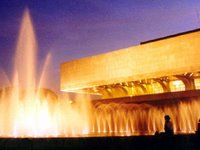 The CCP Main Theater is indeed a sight to behold especially in the evenings with the fountains turned on. A creation of National Artist for Architecture Leandro Locsin, the CCP Complex was the envy of our neighbors when in was newly-constructed. They don't make government buildings like those in the Philippines nowadays, grandiose, elegant and tastefully done. Today, the DPWH and other government agencies charged with construction churn out the ugliest buildings in the world! Four walls and a roof and the rest goes to someone's pockets! Sigh! When will this country start thinking big again?The invitation called for formal Filipiniana attire. Which is why I was so disappointed when I saw a large number of the audience came in semi-formal attire fit for an ordinary day in the office, many even in crew neck t-shirts and maong. Earth to whoever you guys are, you are attending an Independence Day program! Isn't it obvious that the occasion calls for all of us to don our native costumes and be proud of wearing Filipino formal wear just this once?! And we were in the Cultural Center of the Philippines for crying out loud! Plus there were members of the Diplomatic Corps and other important people in attendance. Moreover, it was a gala performance and yet there was a sizeable number of people in clothes fit for the shopping mall or a movie house. Duh!
The CCP Main Theater is indeed a sight to behold especially in the evenings with the fountains turned on. A creation of National Artist for Architecture Leandro Locsin, the CCP Complex was the envy of our neighbors when in was newly-constructed. They don't make government buildings like those in the Philippines nowadays, grandiose, elegant and tastefully done. Today, the DPWH and other government agencies charged with construction churn out the ugliest buildings in the world! Four walls and a roof and the rest goes to someone's pockets! Sigh! When will this country start thinking big again?The invitation called for formal Filipiniana attire. Which is why I was so disappointed when I saw a large number of the audience came in semi-formal attire fit for an ordinary day in the office, many even in crew neck t-shirts and maong. Earth to whoever you guys are, you are attending an Independence Day program! Isn't it obvious that the occasion calls for all of us to don our native costumes and be proud of wearing Filipino formal wear just this once?! And we were in the Cultural Center of the Philippines for crying out loud! Plus there were members of the Diplomatic Corps and other important people in attendance. Moreover, it was a gala performance and yet there was a sizeable number of people in clothes fit for the shopping mall or a movie house. Duh!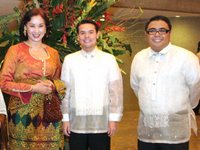 My companion for the evening was our president at the HCS, Gemma Cruz-Araneta. The performances were excellent! But as Gemma noted, the script lacked something, the very essence of the celebrations. That's why in her Manila Bulletin column, Gemma questions this missing element in her piece entitled Woven Amnesia, a play of the English translation of the title Woven Memories since the scriptwriter forgot to present the declaration of independence, the First Philippine Republic and the events of 1898 in the fabric of history symbolically featured.
My companion for the evening was our president at the HCS, Gemma Cruz-Araneta. The performances were excellent! But as Gemma noted, the script lacked something, the very essence of the celebrations. That's why in her Manila Bulletin column, Gemma questions this missing element in her piece entitled Woven Amnesia, a play of the English translation of the title Woven Memories since the scriptwriter forgot to present the declaration of independence, the First Philippine Republic and the events of 1898 in the fabric of history symbolically featured.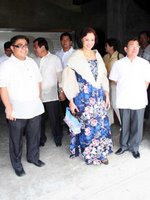 Today was spent in San Fernando to attend the local Independence Day celebrations. I had wanted to attend the reenactment of the 1899 Independence Day celebrations, the first and last Independence Day under the first republic which was held in front of the Pamintuan House in Angeles. But the 7 a.m, calltime was just too early for me and I was still exhausted. Anyway, in San Fernando, our guest of honor and speaker was none other than Gemma who as expected arrived in an exquisite maria clara. Filipinos should really learn to dress for the occasion no matter if the sun is scorching hot.A large parade was arranged by the DepEd with students from each of the 35 barangays of San Fernando presenting tableaus of various historical national and local events on floats. Although I noticed there was a lack of marching bands since the parade was so long and in between bands, there was no music so it looked like a processesion. Hehe! At the Bren Guiao Convention Center, there were thousands of students assembled for the celebrations, watching the parade as it entered the grandstand.
Today was spent in San Fernando to attend the local Independence Day celebrations. I had wanted to attend the reenactment of the 1899 Independence Day celebrations, the first and last Independence Day under the first republic which was held in front of the Pamintuan House in Angeles. But the 7 a.m, calltime was just too early for me and I was still exhausted. Anyway, in San Fernando, our guest of honor and speaker was none other than Gemma who as expected arrived in an exquisite maria clara. Filipinos should really learn to dress for the occasion no matter if the sun is scorching hot.A large parade was arranged by the DepEd with students from each of the 35 barangays of San Fernando presenting tableaus of various historical national and local events on floats. Although I noticed there was a lack of marching bands since the parade was so long and in between bands, there was no music so it looked like a processesion. Hehe! At the Bren Guiao Convention Center, there were thousands of students assembled for the celebrations, watching the parade as it entered the grandstand. The loudest cheers were however given to the vehicle carrying Mikee Lee, first runner-up of the Pinoy Big Brother Teen Edition, who is from San Fernando. Imagine, it was only then that I found out that Mikee was a Cabral from Sta. Lucia, his uncle a former city councilor of San Fernando. His kuya, Peter, was a batchmate at the Ateneo High School and I was telling him that if they highlighted his being a native of San Fernando, the Kapampangans would have given him a solid vote. Hehe! From the cheers, screams, shouts and shrieks of the high school students in the jampacked convention center, I realized the power of television and how one show can change your life overnight. As Peter told me, Mikee was still learning the ropes of stardom and was not used to the adoration. I'm sure!
The loudest cheers were however given to the vehicle carrying Mikee Lee, first runner-up of the Pinoy Big Brother Teen Edition, who is from San Fernando. Imagine, it was only then that I found out that Mikee was a Cabral from Sta. Lucia, his uncle a former city councilor of San Fernando. His kuya, Peter, was a batchmate at the Ateneo High School and I was telling him that if they highlighted his being a native of San Fernando, the Kapampangans would have given him a solid vote. Hehe! From the cheers, screams, shouts and shrieks of the high school students in the jampacked convention center, I realized the power of television and how one show can change your life overnight. As Peter told me, Mikee was still learning the ropes of stardom and was not used to the adoration. I'm sure! After the program, we had lunch at the new city hall site. The aircon was a welcome respite to the scorching heat outside. For the afternoon, Gemma and I went to nearby Guagua and Lubao to check out the municipios for possible inclusion in the calendar.Along the way, we passed by several heritage buildings including the Lopez House in Guagua which were very well-maintained. Gemma was not that satisfied with both municipios. Although they were quite intact, they looked ordinary architecturally speaking.
After the program, we had lunch at the new city hall site. The aircon was a welcome respite to the scorching heat outside. For the afternoon, Gemma and I went to nearby Guagua and Lubao to check out the municipios for possible inclusion in the calendar.Along the way, we passed by several heritage buildings including the Lopez House in Guagua which were very well-maintained. Gemma was not that satisfied with both municipios. Although they were quite intact, they looked ordinary architecturally speaking. In Lubao, we passed by the oldest town church in the province. The retablo was impressive! But sad to say, some priest white-washed the trompe l'oeil murals that once adorned the ceiling. We had wanted to meet with Mayor Dennis Pineda to try to convince him to restore the said murals but he was still incomunicado since the bomb explosion in front of his home. Oh well! Maybe next time when things are a little better. The restoration of those murals would be a very worthwhile project.
In Lubao, we passed by the oldest town church in the province. The retablo was impressive! But sad to say, some priest white-washed the trompe l'oeil murals that once adorned the ceiling. We had wanted to meet with Mayor Dennis Pineda to try to convince him to restore the said murals but he was still incomunicado since the bomb explosion in front of his home. Oh well! Maybe next time when things are a little better. The restoration of those murals would be a very worthwhile project.
It’s been quite a while since I’ve been on a road trip. And today’s itinerary was a spur of the moment decision. Since we needed more photos for the 2007 HCS calendar which would feature capitols, city halls and municipios; and since Gemma said Baliuag has a historical one, I decided to make a detour into northeastern Bulacan on the way back to Manila from Pampanga.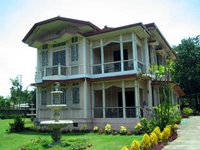 I exited in Pulilan and passed by the town proper (the church is right along the national highway). There were several charming bahay na bato and chalets along the way. Maybe next year I’ll try to watch the Carabao Festival from May 14 to 15, again held in honor of San Isidro Labrador. This festival is also held in San Isidro, Nueva Ecija and Angono, Rizal.
I exited in Pulilan and passed by the town proper (the church is right along the national highway). There were several charming bahay na bato and chalets along the way. Maybe next year I’ll try to watch the Carabao Festival from May 14 to 15, again held in honor of San Isidro Labrador. This festival is also held in San Isidro, Nueva Ecija and Angono, Rizal. From Pulilan, I was off to Baliuag to take a photo of their old municipio which is now a museum. I like the way Baliuag is planned, with a glorieta in the middle of town. The church and convento are well-preserved. In front of the church is a grand monument to Dr. Jose Rizal complete with a pair of sphinxes on either side which is so art deco.
From Pulilan, I was off to Baliuag to take a photo of their old municipio which is now a museum. I like the way Baliuag is planned, with a glorieta in the middle of town. The church and convento are well-preserved. In front of the church is a grand monument to Dr. Jose Rizal complete with a pair of sphinxes on either side which is so art deco.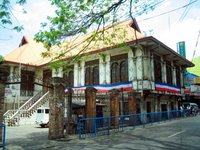 The old municipio is a few meters away along the road to San Miguel. After taking some snapshots, and since I felt like exploring some more, I decided to visit San Miguel de Mayumu since the municipio there was also built during the Spanish colonial period. It however wasn’t the main attraction of the town.I’ve been there several years back and the elegant colonial homes were just splendid! But I was surprised to find many of them in a state of decay, including the three-storey Victorian Cake House which is always featured in coffee table books on Philippine architectural heritage.
The old municipio is a few meters away along the road to San Miguel. After taking some snapshots, and since I felt like exploring some more, I decided to visit San Miguel de Mayumu since the municipio there was also built during the Spanish colonial period. It however wasn’t the main attraction of the town.I’ve been there several years back and the elegant colonial homes were just splendid! But I was surprised to find many of them in a state of decay, including the three-storey Victorian Cake House which is always featured in coffee table books on Philippine architectural heritage.
 There is a twist to the third floor since this was rare in the bahay na bato. According to the story, "a macho farmer married the landowner's daughter. To out-do his father-in-law, the farmer built the tallest house in the area: so that the father, on passing the threshhold, had to look up to his son-in-law! The third level had a massive ballroom where the elite would throw balls as entertainment between sugar crops."
There is a twist to the third floor since this was rare in the bahay na bato. According to the story, "a macho farmer married the landowner's daughter. To out-do his father-in-law, the farmer built the tallest house in the area: so that the father, on passing the threshhold, had to look up to his son-in-law! The third level had a massive ballroom where the elite would throw balls as entertainment between sugar crops." San Miguel is one of the few well-preserved towns which have yet to be declared by the National Historical Institute. Yes, the NHI board has yet to declare San Miguel, Bulacan and many other heritage towns! And while these historians sit down and take their time, many centuries-old homes are going down, taken for granted by the very institution mandated to protect them.
San Miguel is one of the few well-preserved towns which have yet to be declared by the National Historical Institute. Yes, the NHI board has yet to declare San Miguel, Bulacan and many other heritage towns! And while these historians sit down and take their time, many centuries-old homes are going down, taken for granted by the very institution mandated to protect them. How sad it was to see a well-preserved heritage town in such a sorry state. I wonder why the Provincial Government of Bulacan, which I have known to be a staunch advocate of culture and the arts, is allowing these houses to decay and remain in such a state of neglect given that San Miguel’s ancestral homes are among the showcases of the province?
How sad it was to see a well-preserved heritage town in such a sorry state. I wonder why the Provincial Government of Bulacan, which I have known to be a staunch advocate of culture and the arts, is allowing these houses to decay and remain in such a state of neglect given that San Miguel’s ancestral homes are among the showcases of the province?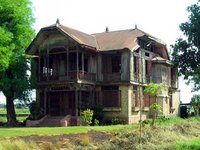 On the way back, I took a photo of the Ilusorio House in San Ildefonso which was along the highway. Aside from its outstanding architectural features, the house stands as a poignant reminder of the horrors of the Second World War where women from an entire barangay (Mapanique, Candaba) were locked and raped repeatedly by their Japanese captors. These wives, mothers and daughters, collectively known as the Malaya Lolas, had lost their husbands, fathers and sons who were tortured and massacred by the Japanese Imperial Army. Sigh!It was also suggested that I pass by San Rafael to check out the old houses. There were some nice ones but not as much as San Miguel. Since I was in San Rafael, might as well visit the church in Angat which was featured in the book of Fathers Javellana and Galende, Great Churches of the Philippines.
On the way back, I took a photo of the Ilusorio House in San Ildefonso which was along the highway. Aside from its outstanding architectural features, the house stands as a poignant reminder of the horrors of the Second World War where women from an entire barangay (Mapanique, Candaba) were locked and raped repeatedly by their Japanese captors. These wives, mothers and daughters, collectively known as the Malaya Lolas, had lost their husbands, fathers and sons who were tortured and massacred by the Japanese Imperial Army. Sigh!It was also suggested that I pass by San Rafael to check out the old houses. There were some nice ones but not as much as San Miguel. Since I was in San Rafael, might as well visit the church in Angat which was featured in the book of Fathers Javellana and Galende, Great Churches of the Philippines. The exterior was charming! But the interior was just shocking, an excessive use of gold leaf! Just to make things clear, what was done inside the Angat Church was a renovation and not a restoration. For it to be a restoration, it must approximate the original interior of the church.The new ceiling murals were just too loud and modern for the old colonial charm of this church. As I told a friend (the one who did the interior was also a friend), you don’t put opulence when it was previously not there. In fact, the elegance of the Angat Church was in its simplicity, now erased by a rampage of gold leaf.One must not impose his style on an old church. That goes for priests, parish pastoral councils and the architects and interior designers they hire to renovate them, who most of the time go overboard with decorations and details. We must leave old churches as they are because these are testaments to the craftsmen and artisans who designed them.Additions should not overpower the original design. I wonder how these architects and interior designers would feel if a hundred years from now, their works would be eradicated by future architects and interior designers who like them impose their style on previous masterpieces.Anyway, enough said. From Angat, it was off to Manila. I took the longer, more scenic route via Norzagaray. The foothills of the Sierra Madre offered a relaxing view. But there were eyesores as well, quarrying plants and their towering machinery. Sigh! The drive was quite long thanks to the slow traffic as I neared Metro Manila. It would take me to San Jose del Monte City, North Caloocan and finally, Fairview where traffic management was horrible! Mayor Belmonte should fire his traffic enforcers and ban undisciplined jeepney drivers. Hmmmm... there wouldn't be any jeeps left then! Hehe! I had driven a total of seven hours! And now it's time for me to rest.
The exterior was charming! But the interior was just shocking, an excessive use of gold leaf! Just to make things clear, what was done inside the Angat Church was a renovation and not a restoration. For it to be a restoration, it must approximate the original interior of the church.The new ceiling murals were just too loud and modern for the old colonial charm of this church. As I told a friend (the one who did the interior was also a friend), you don’t put opulence when it was previously not there. In fact, the elegance of the Angat Church was in its simplicity, now erased by a rampage of gold leaf.One must not impose his style on an old church. That goes for priests, parish pastoral councils and the architects and interior designers they hire to renovate them, who most of the time go overboard with decorations and details. We must leave old churches as they are because these are testaments to the craftsmen and artisans who designed them.Additions should not overpower the original design. I wonder how these architects and interior designers would feel if a hundred years from now, their works would be eradicated by future architects and interior designers who like them impose their style on previous masterpieces.Anyway, enough said. From Angat, it was off to Manila. I took the longer, more scenic route via Norzagaray. The foothills of the Sierra Madre offered a relaxing view. But there were eyesores as well, quarrying plants and their towering machinery. Sigh! The drive was quite long thanks to the slow traffic as I neared Metro Manila. It would take me to San Jose del Monte City, North Caloocan and finally, Fairview where traffic management was horrible! Mayor Belmonte should fire his traffic enforcers and ban undisciplined jeepney drivers. Hmmmm... there wouldn't be any jeeps left then! Hehe! I had driven a total of seven hours! And now it's time for me to rest.
What are people doing to Manila's heritage? It seems the uglification of Manila is moving forward at such an alarming rate. The sad part is our utter disregard for the works of people we call National Artists. Why do we give out the award in the first place if we don't even care whether their works are preserved for future generations of Filipinos to appreciate?I got this from Richard Tuason Bautista of the Heritage Conservation Society, "This morning (3 June 2006) during our taping and inspection of the ongoing demolition of the Avenue Theater and Hotel, we learned from the EVJ Demolition Team, with representation of their general manager Mr. Esteban Toting, that the Galaxy Theatre is next to face the demolition crew."Galaxy theatre is a work of National Artist for Architecture Pablo Antonio. It may not be too late to save this one. But how to save it, an uproar from the public is needed."We should not sit down and simply watch while what's left of the Pearl of the Orient and its capital city, goes down one by one! To the National Commission for Culture and the Arts (NCCA), National Historical Institute (NHI) and the Cultural Center of the Philippines (CCP), it's about time you guys take a stand and protect the works of our National Artists! And to all of us ordinary citizens, let's write Mayor Atienza and tell him to stop giving out demolition permits for Manila's architectural heritage!In fact, the NCCA lists the Galaxy Theater as one of Antonio's major works! Again, for those who would like to save this heritage structure, you can call or fax a complaint to Mayor Lito Atienza at 5276063 or 5274991 or send an e-mail at mayor_atienza@cityofmanila.com.ph.
Check out Ellen Tordesillas' blog for more comments about Atienza's latest rampage.
Related articles
Cinema designed by National Artist faces demolition
 This is the third entry with the word save in such a short span of time. The ignorance of our local government officials, moreso in the nation's capital city, is getting to be really depressing. It seems Mayor Lito Atienza is living up to his name as Manila's heritage destroyer. In the PDI article Arroyo orders rehabilitation of endangered buildings (May 31, 2006), Atienza calls for the demolition of the Luneta Hotel Historical Landmark! It is difficult to fathom how a mayor would even consider doing such.The article says, "However, the mayor called on the DPWH and the owners of abandoned private buildings to demolish the structures because these posed a danger to the public."He cited the Veteran's Bank Building in the Port Area, the Royal Hotel on Carlos Palanca Street and the Luneta Hotel on T.M. Kalaw Avenue, among other buildings."These are abandoned buildings," Atienza said. "Uninhabited structures tend to become brittle as the years pass, and this is dangerous."
This is the third entry with the word save in such a short span of time. The ignorance of our local government officials, moreso in the nation's capital city, is getting to be really depressing. It seems Mayor Lito Atienza is living up to his name as Manila's heritage destroyer. In the PDI article Arroyo orders rehabilitation of endangered buildings (May 31, 2006), Atienza calls for the demolition of the Luneta Hotel Historical Landmark! It is difficult to fathom how a mayor would even consider doing such.The article says, "However, the mayor called on the DPWH and the owners of abandoned private buildings to demolish the structures because these posed a danger to the public."He cited the Veteran's Bank Building in the Port Area, the Royal Hotel on Carlos Palanca Street and the Luneta Hotel on T.M. Kalaw Avenue, among other buildings."These are abandoned buildings," Atienza said. "Uninhabited structures tend to become brittle as the years pass, and this is dangerous." Photos of the Luneta Hotel came from the Heritage Watch Forum. The white building to the right of the hotel is another pre-war structure, the University Club Building.
Photos of the Luneta Hotel came from the Heritage Watch Forum. The white building to the right of the hotel is another pre-war structure, the University Club Building.
The Luneta Hotel was declared a national historical landmark by the National Historical Institute and is thus protected by P.D. 1505. According to the decree, "Sec. 5. It shall be unlawfully for any person to modify, alter, repair or destroy the original features of any national shrine, monument, landmark and other important historic edifices declared and classified by the National Historical Institute as such without the prior written permission from the Chairman of said Institute."Any person who shall violate this Decree shall, upon conviction, be punished by imprisonment for not less than one year nor more than five years or a fine of not less than one thousand pesos nor more than ten thousand pesos or both, at the discretion of the court or tribunal concerned." After chopping down centuries-old trees in Manila's last lung, the Arroceros Forest Park; demolishing the art deco Jai Alai Building in order to build a Hall of Justice which up to today has not begun (the lot where the Jai Alai Building used to stand is still a gaping hole in the ground); building a park and ride facility in the Mehan Gardens Historical Landmark, an archaeologically rich area being the site of Manila's Parian, thus destroying evidences of our rich culture; and getting rid of the YMCA Building and San Lazaro Hippodrome to build SM malls, sad to say SM City Manila now towers over the Manila City Hall and the area has become so congested and ugly; he is at it again! Congratulations for a job well done Mayor Atienza! Kudos to your Patayan ang MayniLA program!
 Just got back from an exhausting but fulfilling day trip to the Cordilleras. Yes, you heard me right, it was a day trip! This time the HCS was off to Bontoc, Mountain Province where a rare American period upland capitol building still stands.
Just got back from an exhausting but fulfilling day trip to the Cordilleras. Yes, you heard me right, it was a day trip! This time the HCS was off to Bontoc, Mountain Province where a rare American period upland capitol building still stands. From Maharlika Highway, we made a left in Bagabag towards Banaue. By the time we entered Ifugao, the sun was up. The scenery along the way was just surreal and we had wanted to stopover by a river for a breakfast picnic but had to abandon the plan since it was difficult to find our way down to the riverbank. We had made it past Lagawe, Ifugao's capital town when we decided to find a spot along the mountain road for our picnic.
From Maharlika Highway, we made a left in Bagabag towards Banaue. By the time we entered Ifugao, the sun was up. The scenery along the way was just surreal and we had wanted to stopover by a river for a breakfast picnic but had to abandon the plan since it was difficult to find our way down to the riverbank. We had made it past Lagawe, Ifugao's capital town when we decided to find a spot along the mountain road for our picnic. We found a clearing where we parked. Gemma had prepared cold cuts, bread, cheese, and steamed brussel sprouts and carrots, a healthy treat indeed! Then we noticed we had a flat tire. And to make things worse, there was one stubborn screw which broke our tire wrench. So the driver had to hitchhike to Banaue to look for a vulcanizing shop for help. Anyway, we were stuck for close to two hours. And by this time, Gemma had sent an SOS to the governor of Mountain Province. So a vehicle was on the way. But Bontoc was two hours away! So we just enjoyed the view and watched an old Ifugao lady weave some cloth the traditional way.
We found a clearing where we parked. Gemma had prepared cold cuts, bread, cheese, and steamed brussel sprouts and carrots, a healthy treat indeed! Then we noticed we had a flat tire. And to make things worse, there was one stubborn screw which broke our tire wrench. So the driver had to hitchhike to Banaue to look for a vulcanizing shop for help. Anyway, we were stuck for close to two hours. And by this time, Gemma had sent an SOS to the governor of Mountain Province. So a vehicle was on the way. But Bontoc was two hours away! So we just enjoyed the view and watched an old Ifugao lady weave some cloth the traditional way. When the driver came back, they were able to replace the tire only to realize that the spare was soft as well. Oh brother! So we made a slow drive to Banaue where we had the tire inflated, pausing briefly for photos with the Banaue Rice Terraces. Sad to say, the view from Banaue town is now that of the Banaue House Terraces! Sigh! And you have to drive further out of town for better views. I wonder why the local government of Banaue did not regulate the construction and development in their area. Didn't they realize that they themselves are destroying the beauty of the rice terraces they are promoting to tourists?
When the driver came back, they were able to replace the tire only to realize that the spare was soft as well. Oh brother! So we made a slow drive to Banaue where we had the tire inflated, pausing briefly for photos with the Banaue Rice Terraces. Sad to say, the view from Banaue town is now that of the Banaue House Terraces! Sigh! And you have to drive further out of town for better views. I wonder why the local government of Banaue did not regulate the construction and development in their area. Didn't they realize that they themselves are destroying the beauty of the rice terraces they are promoting to tourists? A few kilometers from Banaue, we finally saw the vehicle sent by the governor and decided to transfer. Since the driver was already used to driving along the rough mountain road, we were moving faster now. Of course, we could not resist the photo opportunities along the way, views of mountain villages such as Bayyo, perched beside the rice terraces which their ancestors built. Then we saw Bontoc, the capital town which appeared like a hidden metropolis in the mountains. It's sad though that the current architecture in the Philippines is so nondescript and lacks character. The view of Bontoc would have been more charming if the architectural character of the place was maintained.
A few kilometers from Banaue, we finally saw the vehicle sent by the governor and decided to transfer. Since the driver was already used to driving along the rough mountain road, we were moving faster now. Of course, we could not resist the photo opportunities along the way, views of mountain villages such as Bayyo, perched beside the rice terraces which their ancestors built. Then we saw Bontoc, the capital town which appeared like a hidden metropolis in the mountains. It's sad though that the current architecture in the Philippines is so nondescript and lacks character. The view of Bontoc would have been more charming if the architectural character of the place was maintained. We went straight to the capitol to take photos for our 2007 HCS Calendar. The facade of the capitol had just been renovated in April, the wooden windows replace by metal ones. Sigh! But most of it was still intact. So we took our photos.
We went straight to the capitol to take photos for our 2007 HCS Calendar. The facade of the capitol had just been renovated in April, the wooden windows replace by metal ones. Sigh! But most of it was still intact. So we took our photos. After the hearty lunch, we were brought to the Bontoc Museum which was housed in buildings designed like Bontoc huts. Right beside it was an old Catholic school founded in 1911, the St. Vincent's Elementary School which was a complex of wooden and brick buildings (more photos here). I had noticed a sign which showed a new building and fund-raising efforts for it. So I asked where it was going to be built. And to my horror, they were going to demolish some old ones.
After the hearty lunch, we were brought to the Bontoc Museum which was housed in buildings designed like Bontoc huts. Right beside it was an old Catholic school founded in 1911, the St. Vincent's Elementary School which was a complex of wooden and brick buildings (more photos here). I had noticed a sign which showed a new building and fund-raising efforts for it. So I asked where it was going to be built. And to my horror, they were going to demolish some old ones. Our plan was to visit nearby Sagada and Maligcong Rice Terraces but thanks to our flat tire fiasco, we had to make our way back to Manila. Sigh! This time, we stopped along the road for more photos. Despite the rough road which the governor calls the "Bontoc Massage," the view of the natural heritage of the Philippines at its finest makes any trip up the Cordilleras most worth it. I hope it stays that way!
Our plan was to visit nearby Sagada and Maligcong Rice Terraces but thanks to our flat tire fiasco, we had to make our way back to Manila. Sigh! This time, we stopped along the road for more photos. Despite the rough road which the governor calls the "Bontoc Massage," the view of the natural heritage of the Philippines at its finest makes any trip up the Cordilleras most worth it. I hope it stays that way! This marked viewpoint offers one of the better views of the rice terraces in Banaue. I think this viewpoint was the highlight of our trip thanks to the magnificent view and the cool mountain weather. From there, we proceeded to the Banaue Hotel where we had some coffee.
This marked viewpoint offers one of the better views of the rice terraces in Banaue. I think this viewpoint was the highlight of our trip thanks to the magnificent view and the cool mountain weather. From there, we proceeded to the Banaue Hotel where we had some coffee.







































